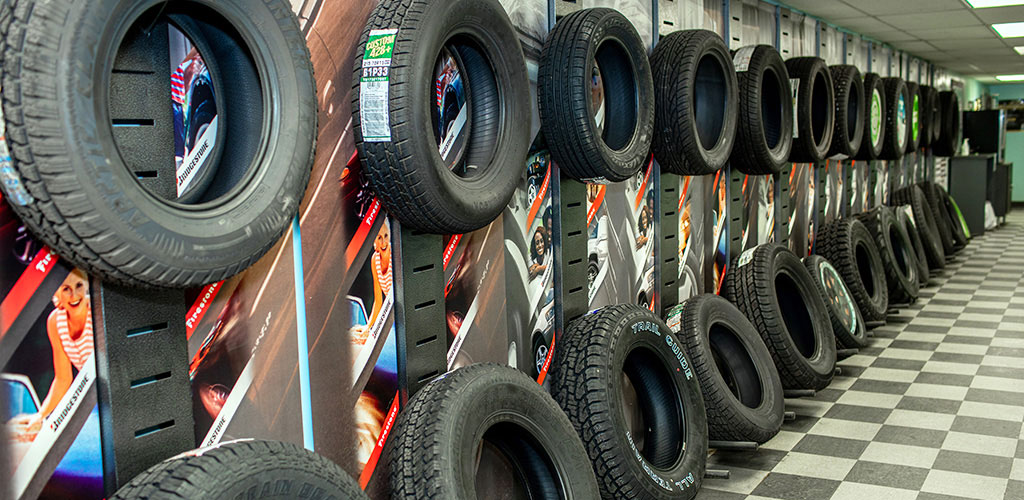The Science Behind Tire Repair Work and Security
When it involves the intricate globe of tire maintenance and security, there exists a realm of scientific research that frequently stays unseen by the average driver - discount tires morris il. The materials that make up a tire, the effect of tire stress on total security, the ramifications of walk wear, the complex dynamics of tire grip, and the often-overlooked relevance of correct wheel positioning all play crucial functions in guaranteeing an automobile operates safely and effectively. As we navigate via the intricacies of tire repair service and security, it becomes evident that a much deeper understanding of these scientific principles is not only helpful yet necessary for every single chauffeur when driving
Tire Composition and Functionality
What products make up the make-up of tires, and how do these parts add to their functionality when traveling? Tires are intricate products, generally made from a combination of rubber compounds, fabric, steel cords, and various other chemical additives. The most common kind of rubber made use of in tires is artificial rubber, which provides durability and resistance to tear and use. The textile layers, typically constructed from nylon, polyester, or rayon, provide stamina and stability to the tire framework. Steel cables are incorporated to boost the tire's strength and aid it preserve its form under different road problems.
The composition of tires plays an important function in their capability on the road - discount tires morris il. The rubber substances offer grasp and grip, enabling the tire to abide by the road surface area and offer security during velocity, braking, and cornering. The material and steel layers add to the tire's ability to hold up against stress, preserve its shape, and sustain the automobile's weight. Overall, the careful selection and combination of these products make sure that tires can perform efficiently and securely on various road surface areas and conditions.
Influence of Tire Pressure on Safety
On the other hand, overinflated tires have much less contact with the roadway surface area, lowering grip and causing unequal wear on the tire treads. Effectively inflated tires additionally play a vital duty in gas efficiency, as underinflated tires can raise moving resistance, leading to reduced gas mileage. On a regular basis examining and keeping the right tire stress not only ensures safety and security yet likewise extends the life expectancy of the tires, conserving on replacement expenses in the lengthy run.
Footstep Use and Its Ramifications
Correct tracking of tire walk wear is important for ensuring optimal efficiency and safety when driving. As tires use down, the depth of the walk diminishes, decreasing the tire's capability to preserve traction, especially in damp or slippery problems. The walk pattern and deepness play an essential function in channeling water far from the tire to avoid hydroplaning and keeping hold when driving surface area.
Indicators of excessive walk wear consist of bald spots, unequal wear, and the look of wear signs. Bald places indicate local wear, morris tire service which can result in instability and raised risk of blowouts. Uneven wear may recommend issues with tire placement, rising cost of living, or suspension elements. Wear signs are developed right into the tire step and become visible when the step deepness gets to a certain nadir, indicating the demand for immediate substitute.

Comprehending Tire Traction Dynamics
Keeping an eye on tire step wear not just ensures ideal performance and safety however additionally straight influences the traction dynamics of the tires on various roadway surface areas. Tire grip is a critical element of lorry handling and safety and security, as it establishes the grip in between the tires and the road. Grip dynamics vary depending upon roadway conditions such as dry sidewalk, damp roadways, snow, or ice.

Comprehending tire traction dynamics is important for vehicle drivers to adjust their driving actions according to the roadway problems. morris tire. Frequently checking tire walk depth and problem can substantially improve grip efficiency, ensuring much safer driving experiences throughout different surface areas
Relevance of Correct Wheel Alignment
Making sure right wheel placement plays a crucial duty in enhancing vehicle efficiency and expanding tire longevity. Correct wheel alignment involves changing the angles of the wheels to supplier specs, making sure that they are vertical to the ground and alongside each other. When alignment is off, it can cause unequal tire wear, reduced fuel performance, and endangered handling.
Among the crucial advantages of maintaining appropriate wheel alignment is enhanced dealing with and security. Misaligned wheels can trigger the vehicle to pull to one side, affecting steering control and total driving experience. Additionally, appropriate alignment advertises also tire wear, stopping premature tire replacement and minimizing maintenance costs over time.
Conclusion
In final thought, the science behind tire repair and safety and security is essential for preserving car efficiency and making sure vehicle driver safety and security. By recognizing tire composition, stress, step wear, grip characteristics, and wheel alignment, drivers can avoid accidents and prolong the life expectancy of Homepage their tires.
The products that compose a tire, the effect of tire stress on total security, the ramifications of step wear, the elaborate characteristics of tire grip, and the often-overlooked importance of proper wheel placement all play vital roles in guaranteeing a car operates safely and efficiently. On the various other hand, overinflated tires have less call with the roadway surface, reducing traction and triggering irregular wear on the tire treads. Routinely inspecting and preserving the right tire stress not just look at this site ensures security but additionally expands the lifespan of the tires, conserving on substitute prices in the lengthy run.
Checking tire tread wear not only ensures optimal efficiency and security yet additionally directly influences the traction dynamics of the tires on different road surface areas. Tire grip is a crucial aspect of vehicle handling and security, as it identifies the grip between the tires and the roadway.